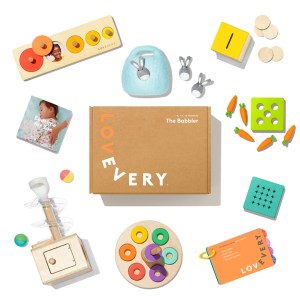The pincer grasp is not just for babies

The pincer grasp—the coordination of thumb and index finger to perform a task—is a crucial piece of fine motor development. As adults, we use it for all kinds of things, including buttoning a shirt and picking up tiny objects. The pincer grasp is usually considered a baby skill, but your toddler needs opportunities to practice it as well, particularly as pre-writing habits begin to form.
More and more children are entering school with inadequate fine motor skills and hand strength. Doctors warn that an increase in tech use is making it harder for kids to properly grasp a pencil down the line. This becomes a concern for your child’s developing hand, finger, and wrist muscles. Hand-held devices have replaced many of the toys that traditionally worked those muscles. Toys with loose or moving parts require your toddler to manipulate them with hands and fingers; building those muscles is essential not only for writing, but for other future tasks as well.
Toddlers naturally enjoy activities that build their fine motor skills. The knobs on a puzzle, the Mosaic Button Board, and bead kits are great tools to encourage your toddler to use their thumb and pointer finger in a precise pincer grasp.
Fine motor pincer grip activities for toddlers
Putting buttons on the Button Board
The Mosaic Button Board (pictured above) is great for building dexterity and hand strength.
Threading beads

Toddlers usually get the hang of threading one or more beads onto a string between 20 and 23 months. The dowel and the shape of the beads in the Threadable Bead Kit are designed to help your toddler enjoy this activity a little earlier.
Building with blocks

Balancing one block on top of another is a fine motor skill that toddlers grow into. Between 18 and 22 months, your toddler will likely be able to build a tower with four blocks. Then, by about age two, they can build a tower with up to six blocks. More about building with blocks here.
Imitating lines and circles

Making vertical lines, circle scribbles, and horizontal lines are all part of the progression of your toddler’s fine motor development. Check out more about the stages of drawing here.
Using scissors

Your toddler is ready for kid scissors between 23 and 25 months. Give them a piece of paper and show them how to snip off bits of it with the scissors.
Playing with play dough

Your child’s hands get stronger and more capable as they play with play dough. Hesitation about touching the dough and confusion about its texture are common. Help your toddler get more comfortable by showing them how to poke, squish, and roll. You don’t need special tools; you can use ice lolly sticks, cookie cutters, and spoons.
Tweezing

Transferring objects from one container to another is a classic Montessori activity, and most toddlers naturally love to use tweezers. Put pompoms, the Felt Stars, or dried pasta (penne or rigatoni would be the perfect size) into one of the Nesting Cups and show your toddler how to use the tweezers to transfer the items from one cup to another. You can also use the tweezers to transfer into different types of containers, like small bowls, egg cartons, and muffin tins.
Transferring

Transferring objects like raw beans or rice with a soup spoon from one bowl to another is also an activity commonly practised in Montessori toddler classrooms. You might be surprised to see how deeply absorbed your toddler gets as they transfer.
In this post

The Play Kits
The Play Kits by Lovevery are thoroughly tested, baby safe, eco-friendly and Montessori inspired. Give your child the best start with our stage-based play toy subscription boxes.
Learn more
The Block Set
A brilliant set of 70 quality solid-wood blocks for building spatial, language, and problem-solving skills for more than 20 stage-based activities. See inside The Block Set by Lovevery.
Learn morePosted in: 22 - 24 Months, Fine Motor, Milestones, Problem Solving, Real World Play, Child Development
Keep reading

22 - 24 Months
25 - 27 Months
28 - 30 Months
31 - 33 Months
34 - 36 Months
Our favourite birthday and holiday gift ideas for 2-year-olds
These fun gift ideas for 2-year-olds support their motor skills, independence, and creativity.

19 - 21 Months
22 - 24 Months
25 - 27 Months
28 - 30 Months
31 - 33 Months
34 - 36 Months
What kind of chores are right for my child?
Children as young as 18 months can start taking on regular household responsibilities. These will be simple and straightforward, like wiping up spills or helping set the table, and will require modeling and patience from you.


22 - 24 Months
Welcome to The Companion Play Kit for months 22-24
Watch Lovevery CEO Jessica Rolph introduce the CompanionPlay Kit for months 22 to 24 of your toddler's life.
